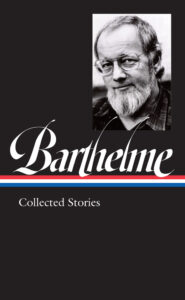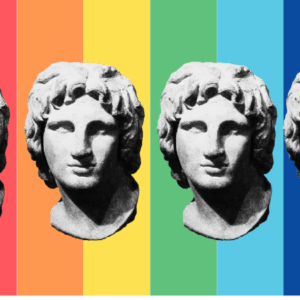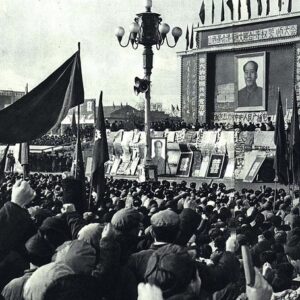
Charles McGrath: On the Avant-Garde Literary Genius of Donald Barthelme
“His fallback, his signature, is always humor.”
Donald Barthelme was, by his own design, a hard writer to categorize. Even at the height of his fame, in the late 70s and early 80s, there were readers who just didn’t get him, or suspected his work was a hoax or a joke they weren’t in on. At The New Yorker, where he was a regular contributor for decades, clerks in the library were expected to type up on index cards brief summaries of every article, fact or fiction, that appeared in the magazine. Barthelme’s cards sometimes contained just one word: “gibberish.”
By most standards, many of his stories aren’t stories at all. They don’t have plots, or even realistic, believable characters, and they touch on human emotion only indirectly. Barthelme loved arcane vocabulary, and called such pieces “slumgullions”—stews, that is. In the manner of visual artists like Duchamp and Rauschenberg, they incorporated all sorts of found materials: snippets from ad copy, old travel guides, textbooks, and instruction manuals, even other writers. The range of references and allusions in his stories is vast and encyclopedic: cheesy movies, nineteenth-century philosophers, opera, country-and-western, military history, art, architecture, softcore pornography. For a while he even took to illustrating his work with engravings and pictures clipped from old books and magazines. He once wrote, only half-joking, that “the most essential tool for genius today” was rubber cement.
Many of the stories feel like riffs, jazzy improvisations on the way people speak: musician-talk, military lingo, art-jargon, academic highbrow. He was like his character Hokie Mokie, in the story “The King of Jazz,” of whom it is said, he “can just knock a fella out, just the way he pronounces a word. What intonation on that boy! God almighty!” Still other stories are retellings, or reimaginings, of older stories: Captain Blood, Bluebeard, the Hunchback of Notre Dame. Barthelme’s version of Balzac’s Eugénie Grandet includes a reference-book summary of the novel; a woodcut of Eugénie herself, holding a ball for some reason; and the word “butter” repeated ninety-seven times.
Donald Barthelme was, by his own design, a hard writer to categorize.
Barthelme was also fascinated by the trite and clichéd, and sometimes incorporated snatches of writing that were deliberately clumsy and hackneyed, or else close to incomprehensible, like this one, from “Paraguay,” a story that also includes lengthy cribbings from obscure books:
Relational methods govern the layout of cities. Curiously, in some of the most successful projects the design has been swung upon small collections of rare animals spaced (on the lost-horse principle) on a lack of grid. Carefully calculated mixes: mambas, the black wrasse, the giselle. Electrolytic jelly exhibiting a capture ratio far in excess of standard is used to fix the animals in place.
One of his favorite devices was the list, an occasion for tossing in all sorts of rag-picked stuff just for its own sake: “two ashtrays, ceramic, one dark brown and one dark brown with an orange blur at the lip; a tin frying pan; two-litre bottles of red wine; three-quarter-litre bottles of Black & White, aquavit, cognac, vodka, gin, Fad #6 sherry; a hollow-core door in birch veneer on black wrought-iron legs; a blanket, red-orange, with faint blue stripes; a red pillow and a blue pillow; a woven straw wastebasket; two glass jars for flowers; corkscrews and can openers; two plates and two cups, ceramic, dark brown; a yellow-and-purple poster; a Yugoslavian carved flute, wood, dark brown; and other items.” Many stories of this assembled sort have an almost painterly quality; they remind you of Warhol sometimes, in their fascination with found objects and cultural detritus, and of Kurt Schwitters, in their collage-like layering of seemingly random elements.
But toward the end of his career Barthelme wrote stories so minimal and pared-down they were almost abstract, just alternating lines of overheard conversation preceded by a dash. Almost from the beginning, there were also stories that were monologues, stories that took the form of a catechism or a Q&A, stories that were out-and-out parodies, stories within stories, stories in the form of numbered lists, stories disguised as essays or interviews, and one story that consists of a single unfinished sentence seven pages long. Barthelme even wrote a few stories that seemed old-school, with real people and actual beginnings, middles, and ends. Late in his life he wrote a prize-winning children’s book, and though his gifts were not really novelistic, he nevertheless wrote four novels—extended, book-length narratives that paid a certain homage to the old conventions of the novel while also undermining them from within. If there’s a constant in his career, it’s restlessness and a dread of seeming predictable.
Barthelme hated labels, but grudgingly accepted that “postmodernist” might not be too far off the mark, and biologically, at least, he really was one. His father, Donald, Sr., was an architect who ardently championed the work of Walter Gropius, Mies van der Rohe, Frank Lloyd Wright, and Le Corbusier. Modernism in the Barthelme household was practically a religion. The family lived in a modern house, designed by Don, Sr., so radical in its time and place, a Houston suburb in the 50s, that people used to park outside and gawk. The furniture was modern, and so were the paintings and the books. The father was impatient and imperious, and he and his namesake, his eldest child, were frequently at odds. But Barthelme nevertheless inherited from his father an unassailable conviction that there had been a revolution in art, and that there was no going back to the old ways.
The contemporaries Barthelme allied himself with were of a similar bent, anxious to dispense with the tired and old-fashioned: Walter Abish, Robert Coover, William Gass, William Gaddis, Jerome Klinkowitz, John Hawkes, John Barth, Joseph McElroy, Susan Sontag, and Thomas Pynchon. In 1983 he famously invited them all to a meal at a SoHo restaurant. (Pynchon, it goes without saying, was a no-show.) The occasion came to be known as the Post-Modernists’ Dinner, and probably entailed a lot of wine and a certain amount of unspoken invidiousness, since some of his contemporaries resented Barthelme’s success at The New Yorker and privately accused him of selling out. Barthelme differed from his fellow postmoderns in at least two respects. He had little use for the notion of “metafiction,” so much in vogue back then: the idea that writing should call attention to its own made-upness. And he lacked the high seriousness of so many postmods, their habit of making grand pronouncements. Barthelme accepted that the age in which he found himself was not a golden one.
But toward the end of his career Barthelme wrote stories so minimal and pared-down they were almost abstract, just alternating lines of overheard conversation preceded by a dash.
He never pretended to greatness, and he made fun of those who did. His fallback, his signature, is always humor. For all his avant-gardism, and occasional difficulty, he is a very funny writer, even a jokey one at times. He’s more entertaining to read, and requires less heavylifting, than many of the postmoderns, and he enjoyed more popular success than just about any of them.
For much of the 1970s, in fact, if slush-pile submissions to The New Yorker were any indication, Barthleme was the most widely imitated writer in America. I was a young editor then and every week would come across a dozen or so wannabe Barthelmes. In 1973 one enterprising forger even managed to sell a passable Barthelme imitation—not to The New Yorker but to one of the little quarterlies. “Quite a worthy effort, as pastiches go,” Barthelme said of it, “and particularly successful in reproducing my weaknesses.” But Barthelme’s heyday was short-lived. In a few years his imitators had been replaced by writers trying to copy Raymond Carver and the slush pile now overflowed with stories set in trailer parks.
The Barthelme example proved to be not just harder to copy than it looked but also so original it didn’t lead anywhere. You can see glints and traces of Barthelme in writers like Donald Antrim, Mary Robison, George Saunders, Nicholson Baker, and Dave Eggers, but Barthelme never inspired a whole school of fiction writing the way Carver did. Where Carver is rooted in the deepest tradition of American realism, Barthelme seems to come out of nowhere. Before becoming a full-time writer, he worked as a museum director and editor of an arts magazine, and his roots, such as they were, were as much in the visual arts as in literature. He’s a one-off, and that turns out to be his greatest claim on posterity: he’s like no one else. He also embodies, more inventively and more entertainingly than any of his contemporaries, that moment in American fiction when so many writers were seized by a need to kill off their ancestors, throw out the old forms, and make everything new. One of his best stories, “A Manual for Sons,” later part of a novel, is a sort of guidebook to that moment: it’s about how to cope with dead fathers who won’t stay dead.
That Barthelme had such a long and fruitful relationship with The New Yorker—publishing 129 stories there over 26 years, not to mention dozens of “Notes and Comment” pieces, and even filling in as a temporary film reviewer in the 70s— now seems remarkable, for he was in many ways the least likely New Yorker contributor ever. He was consciously arty, for one thing, with a formidable, bristling intellect, at a time when the magazine maintained a tone of studied casualness and unpretentiousness. He cultivated a long, mustache-less beard, which made him look like an Amish farmer or else Captain Ahab. Nor was his work especially well liked by many on the staff. The writer and editor William Maxwell said he just didn’t get what Barthelme was up to, but whatever it was, it wasn’t fiction, and the magazine’s then managing editor used to stalk testily around the office and quiz people: Did they really understand this Barth-helm, or however he said his name?
He never pretended to greatness, and he made fun of those who did. His fallback, his signature, is always humor.
But he had two important allies: Roger Angell, the editor who discovered him, and William Shawn, the magazine’s editor-in-chief, who readily embraced Barthelme, as he did so many experimental writers. In the beginning, what Shawn and Angell saw in Barthelme was probably another humorist, in the tradition, say, of S. J. Perelman, whose work Barthelme began to admire when he was still in high school, and who got him to start reading The New Yorker in the first place. His first published piece in the magazine, in the issue of March 2, 1963, was not one of his slumgullions but what The New Yorker called a “casual,” a piece of light humor—in this case, a parody of an Antonioni screenplay.
As Barthelme’s work began to evolve in new and more daring directions Shawn and Angell stuck with it—they even relaxed, just for him, some of the magazine’s usual fussiness about punctuation—and the relationship proved mutually beneficial, as it did with so many longtime New Yorker contributors. In this case, Barthelme got an audience, something like a steady income (though it was never enough, and he was frequently in debt to the magazine), and the freedom to experiment. The magazine got a controversial but also widely admired writer who helped dispel the cloud of the so-called New Yorker story: the magazine’s reputation—outdated then but still lingering—for publishing stories that were mostly plotless evocations of suburban ennui. Barthleme’s plotlessness was of a different, more disconcerting sort. It left readers without any of the bearings supplied by traditional fiction. Sometimes you didn’t have a clue as to where you were. Here, for example, is the beginning of “The Indian Uprising,” a famous early story that is in part a response to the Vietnam War, though you could be forgiven for not guessing that right away:
We defended the city as best we could. The arrows of the Comanches came in clouds. The war clubs of the Comanches clattered on the soft, yellow pavements. There were earthworks along the Boulevard Mark Clark and the hedges had been laced with sparkling wire. People were trying to understand. I spoke to Sylvia. “Do you think this is a good life?” The table held apples, books, long-playing records. She looked up. “No.”
But even the most collage-like of his stories were not mere abstractions, devoid of feeling or meaning. Barthelme distrusted the means of traditional fiction but not its end—to help make sense of things, a job rendered even more difficult, he thought, by the cluttered and cheapened culture in which he found himself. To a surprising extent, some of his work is even autobiographical. Barthelme drank too much and often felt guilty about it, and drinking, or regret about drinking, is a not uncommon theme in his work. He was also lonely and lovelorn; he married four times, and had a great many affairs. Romantic disappointment and sexual longing are even more frequent themes in the stories, and sometimes the drinking and the disappointment are combined: “Our evenings lacked promise. The world in the evenings seems fraught with the absence of promise, if you are a married man. There is nothing to do but go home and drink your nine drinks and forget about it.”
One of Barthelme’s better collections was called Sadness, and sadness is the default mood in most of his work. Not full-blown despair of the sort you find in Beckett, a writer Barthelme greatly admired, but melancholy, regret, disappointment, a sense of belatedness and unrequited longing, a feeling that life seldom turns out the way you’d hoped. But Barthelme’s sadness is tempered by his omnipresent humor, and by a sense that, on second thought, maybe things aren’t so bad after all. His story “The Leap of Faith” is probably inspired by that moment in Beckett’s The Unnameable when the narrator says, “I can’t go on. I’ll go on.” Barthelme’s version, though unmistakably in Beckett’s manner, is less urgent and angst-ridden. Two characters are talking about whether or not to make a leap of faith—to find something, anything, worth believing in. “I can’t make it,” one of them says, but then they agree to keep trying, to try again another day. It ends this way:
—Another day when the singing sunlight turns you every which way but loose.
—When you accidentally notice the sublime.
—Somersaults and duels.
—Another day when you see a woman with really red hair. I mean really red hair.
—A wedding day.
—A plain day.
—So we’ll try again? Okay?
— O k a y.
—Okay?
— O k a y.
There’s always another day in Barthelme, a redemptive sense of open-endedness, and a belief that small miracles are sometimes possible. Barthelme’s great story “The School” is set in a nursery school where a series of escalating catastrophes takes place. First the orange trees planted by the children die. Then the pet snakes and the herb garden—after, that is, the deaths of the gerbil, the white mice, the salamander. It gets worse: the puppy, the Korean orphan, heart attacks, a suicide, a drowning among the parents. The sense of impending doom is macabre but somehow hilarious at the same time. And then the notquite-miracle takes place. There’s a knock at the door, the new gerbil walks in, and the children cheer wildly. It’s not precisely what they were hoping for—they wanted the teacher and his teaching assistant to have sex right there in front of them—but for now it’s enough.
And sadness is the default mood in most of his work. Not full-blown despair of the sort you find in Beckett, a writer Barthelme greatly admired, but melancholy, regret, disappointment, a sense of belatedness and unrequited longing
There are lots of such moments in Barthelme—not happy endings, exactly, but provisional ones, a hopefulness conjured sometimes out of nothing more than the author’s wish not to leave us (and himself) too far down in the dumps. For all his difficulty and occasional impenetrableness, Barthelme was at heart a generous writer who thought that his main task, especially in what he saw as a belated and diminished time, was to sneak up on the readers and startle them with a little dose of pleasure and surprise.
He wasn’t just good at endings. Unlike many writers, he also had a knack for titles: “Some of Us Had Been Threatening Our Friend Colby,” “Kierkegaard Unfair to Schlegel,” “Our Work and Why We Do it,” “The Falling Dog,” “Nothing: A Preliminary Account.” He gave his collections irresistible names like Come Back, Dr. Caligari and Unspeakable Practices, Unnatural Acts, and he fussed over them. He designed the jackets and cover art himself, chose his own typefaces, tweaked and retweaked the contents and their order. If so many of his stories are collage-like, the same is true, on an even larger scale, for the collections themselves. The final one, Overnight to Many Distant Cities, even has mysterious interchapters, italicized fragments that function much the same way as those little newspaper snippets and ticket stubs in the collages of Braque and Picasso. They add a kind of texture, a connection to the world outside the picture frame or, in this case, the frame of the book. Barthelme puts it this way on the first page, right after the table of contents: “They called for more structure, then, so we brought in some big hairy four-by-fours from the back shed and nailed them into place with railroad spikes.”
He thought of the collections not as compendiums—periodic sweepings-up of whatever work he had on hand—but as carefully arranged wholes where everything from the title to the cover art to the flap copy to the unsmiling, Ahab-like author photo at the back contributed to a unified effect. The individual volumes really are different in tone and feeling from one another— some more serious, some more playful—and, read in order, they don’t just show an arc of development, they offer a clue to Barthelme’s own thinking about what he was doing. He never wasted much, and in later books even repurposed old material, but he also made things harder for himself by rejecting anything that seemed easy or formulaic. The later work is gloomier, more death-haunted than the earlier, but never without that glimmer of hopefulness. The last line of that final individual collection, Overnight to Many Distant Cities, is a kind of cosmic weather prediction, promising but open-ended: “Tomorrow, fair and warmer, warmer and fair, most fair . . .”
__________________________________

From Donald Barthelme: Collected Stories (Loa #343) by Donald Barthelme, edited by Charles McGrath. Used with the permission of Library of America.
Charles McGrath
Charles McGrath, known as Chip, is the former deputy editor of The New Yorker and a former editor of The New York Times Book Review, and is currently a contributing writer at The Times. He is the editor of Golf Stories, two Library of America volumes, and an occasional contributor to Golf Digest. He lives with his wife in northern New Jersey and southeastern Massachussetts.












